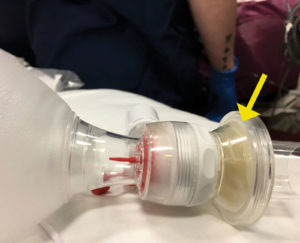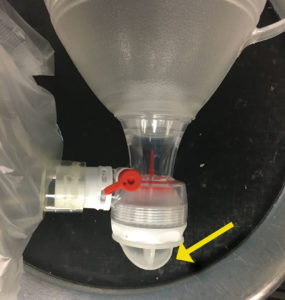Editor’s Note: The clogged filter in this case is not unique to this product and can be seen in any device similar to this particular one.
Dear Rapid Response:
A 65-year-old intubated woman with sepsis and new onset end-stage renal disease requiring dialysis presented to the interventional suite for dialysis catheter insertion. The procedure was uneventful, and the patient remained intubated for transport to the ICU. During transport, it became increasingly difficult to manually ventilate the patient with the self-inflating Ambu® bag (Ambu Inc., Columbia, Maryland) attached to the endotracheal tube (ETT). The patient then developed hypotension, hypoxemia, and subsequent PEA arrest. During resuscitation, the anesthesia professional noted that the Ambu® bag expiratory valve filter was obstructed with secretions. Therefore, the ETT was disconnected from the Ambu® bag, which led to an audible rush of air that subsequently resulted in return of circulation.
With inadequate expiratory time, incomplete exhalation, and so called auto positive end-expiratory pressure (auto-PEEP) can occur in mechanically ventilated patients.1,2,3 It is most commonly seen in patients with severe asthma or chronic obstructive pulmonary disease, but can occur in patients without lung disease. It can result in increased work of breathing, inadequate ventilation, barotrauma, and hemodynamic instability.1,2 Professionals should be aware of preventative strategies, detection, and treatment of auto-PEEP.2,3 We present a case of cardiac arrest secondary to auto-PEEP with return of spontaneous circulation after relief of the mechanical expiratory airflow obstruction (Figure 1).
PEEP is defined as positive pressure in the alveoli at the end of exhalation. Auto-PEEP is an unintended increase in alveolar pressure when complete exhalation is not achieved and may progressively increase.1 This may occur due to several reasons. In our case, it was obstruction of exhalation secondary to a clogged expiratory filter (Figure 1). Over-ventilation is always a concern with manual ventilation; however, in our case this possibility was exacerbated by the fact that exhalation was blocked and “stacked” breaths (auto-PEEP) quickly led to cardiovascular collapse. Subsequently, the filter was removed from all Ambu® bags in our system and instead replaced with a splash guard (Figure 2). The guard provides protection for the professionals while eliminating the risk of expiratory filter obstruction due to soiling with secretions or blood. The expiratory filter is still commercially available for Ambu® bags, and we believe it is important to share this case report to increase awareness and prevent further catastrophic events similar to this.
Dr. Gerasimov is an assistant professor in the anesthesia department at Donald and Barbara Zucker School of Medicine at Hofstra Northwell.
Dr. Toor is a pain fellow at Northwestern University Medical Center at Northwestern Memorial Hospital.
References
- Berlin D. Hemodynamic Consequences of Auto-PEEP. Journal of Intensive Care Medicine. 2012;29:81–86.
- Mughal MM, Culver DA, Minai OA, Arroliga AC. Auto-positive end-expiratory pressure: mechanisms and treatment. Cleveland Clinic Journal of Medicine. 2005;72:801–809.
- Reddy VG. Auto-PEEP: how to detect and how to prevent. Middle East J Anesthesiol. 2005;18:293–312.
Reply:
The use of detachable accessories such as filters is very common with disposable resuscitators of all kinds, whether they come prepackaged with the device or are purchased and attached separately. Expiratory filters are designed to protect the caregiver by filtering out various potentially harmful pathogens on a microscopic level, and are not designed to overcome clogging due to a patient vomiting or expelling thick lung secretions. The expiratory filter we package with the Ambu SPUR II resuscitator is not an Ambu-manufactured product, but has been tested to perform within the requirements of the ISO standard for bacterial/viral filters. These same filters are used in conjunction with manual resuscitators from various manufacturers with the same restrictions and standards applied.
This being the case, the unfortunate patient scenario that has been described by Drs. Gerasimov and Toor would have likely played out the same way regardless of what type of resuscitator was being used to ventilate the patient. As soon as the patient secretions were discovered, the filter should have been removed and the airway cleaned out. If this didn’t resolve the issue, a new resuscitator should have been used to resume ventilation. Additionally, the auto-PEEP described in the report is to be expected when adding accessories like filters or PEEP valves to resuscitators or airway circuits. Our product information for use (IFU) describes potential scenarios like these and how they should properly be addressed when they occur. Similar language should be found in the IFU from any device manufacturer, suggesting the risks presented by using these accessories are common across the spectrum of manual disposable resuscitators on the market.
Respectfully,
Sanjay Parikh, Director, QA/RA
Ambu Inc., 6230 Old Dobbin Lane, Suite 250
Columbia, MD
The information provided is for safety-related educational purposes only, and does not constitute medical or legal advice. Individual or group responses are only commentary, provided for purposes of education or discussion, and are neither statements of advice nor the opinions of APSF. It is not the intention of APSF to provide specific medical or legal advice or to endorse any specific views or recommendations in response to the inquiries posted. In no event shall APSF be responsible or liable, directly or indirectly, for any damage or loss caused or alleged to be caused by or in connection with the reliance on any such information.


 Issue PDF
Issue PDF
